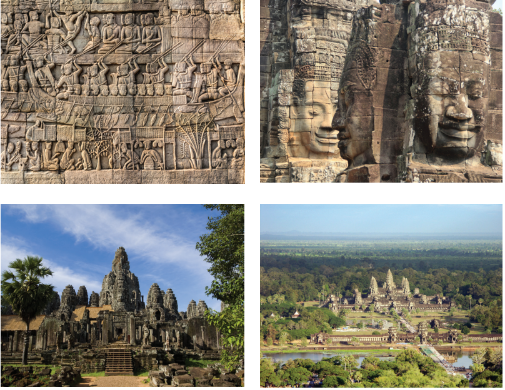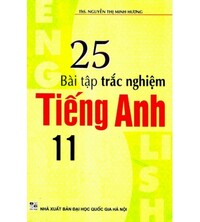Tiếng Anh 11 Unit 5 5.3 Listening
1. Look at the photos. Discuss in pairs and answer the questions: 2. Listen to a radio program about Angkor Wat. Choose the best option. 3. Listen again and complete the sentences with ONE NUMBER from the recording. 4. Use the words or phrases below to fill in the blanks. 5. Work in pairs. Ask and answer about Angkor Wat. You should talk about history, location and size, cultural and architectural significance, tourism and others.
Bài 1
1. Look at the photos. Discuss in pairs and answer the questions:
(Nhìn vào những bức ảnh. Thảo luận theo cặp và trả lời câu hỏi)
1. What is the name of this place?
(Tên của nơi này là gì?)
2. What do you know about this World Heritage site?
(Bạn biết gì về di sản thế giới này?)

Lời giải chi tiết:
1. This is Angkor Wat.
(Đây là đền Angkor Wat.)
2. Angkor Wat, which is a temple complex, is a symbol of Cambodia. It was built in the 12th century by King Suryavarman II. It was in 1992 that Angkor Wat was recognized as a World Heritage site.
(Angkor Wat vốn là quần thể đền đài, là biểu tượng của đất nước Campuchia. Nó được xây dựng vào thế kỷ 12 bởi vua Suryavarman II. Đó là vào năm 1992, Angkor Wat được công nhận là Di sản Thế giới.)
Bài 2
2. Listen to a radio program about Angkor Wat. Choose the best option.
(Nghe một chương trình phát thanh về Angkor Wat. Chọn phương án đúng nhất.)
1. Why is Angkor Wat recognized as a World Heritage site?
(Vì sao Angkor Wat được công nhận là Di sản thế giới?)
a. Because of its beauty
(Vì vẻ đẹp của nó)
b. Because of its historical significance
(Vì ý nghĩa lịch sử của nó)
c. Because of the great number of tourists it attracts
(Vì số lượng khách du lịch lớn nó thu hút)
d. Because of its architectural and cultural significance
(Vì ý nghĩa kiến trúc và văn hóa của nó)
2. What is NOT TRUE about Angkor Wat?
(Điều gì KHÔNG ĐÚNG về Angkor Wat?)
a. Many buildings were constructed by Khmers.
(Nhiều tòa nhà được xây dựng bởi người Khmer.)
b. Many decorations on the buildings are Buddist art.
(Nhiều đồ trang trí trên các tòa nhà là nghệ thuật Phật giáo.)
c. A campaign was held by local people to preserve Angkor Wat.
(Một chiến dịch được tổ chức bởi người dân địa phương để bảo tồn Angkor Wat.)
d. Constructions around Angkor Wat result in great damage to the site.
(Công trình xây dựng xung quanh Angkor Wat dẫn đến thiệt hại lớn cho địa điểm.)
Bài 3
3. Listen again and complete the sentences with ONE NUMBER from the recording.
( Nghe lại và hoàn thành các câu với MỘT SỐ từ đoạn ghi âm.)
1. Angkor Wat was built in the ______ century.
2. The total of the temple complex is ______ hectares.
3 King Jayavarman VII reconstructed the temple complex in ______.
4. It became a World Heritage site in ______.
5. Tourist numbers grew from 7,650 to ______ million by 2018.
Bài 4
4. Use the words or phrases below to fill in the blanks.
(Sử dụng các từ hoặc cụm từ dưới đây để điền vào chỗ trống.)
|
monument religious decorations dynasty international efforts |
1. The place is full of ______ and they tell a lot about the religious beliefs of the Khmer.
2. The ______ of King Jayavarman VII makes him look like a Buddhist monk.
3. A ______ is a family of rulers who have ruled a kingdom for many generations.
4. A lot of ______ have been made to preserve the temples.
Phương pháp giải:
monument: đài tưởng niệm
religious decorations: trang trí tôn giáo
dynasty: triều đại
international efforts: nỗ lực của quốc tế
Lời giải chi tiết:
1. The place is full of religious decoration and they tell a lot about the religious beliefs of the Khmer.
(Nơi đây đầy những trang trí tôn giáo và họ nói rất nhiều về tín ngưỡng tôn giáo của người Khmer.)
2. The monument of King Jayavarman VII makes him look like a Buddhist monk.
(Tượng đài của Vua Jayavarman VII khiến ông trông giống như một tu sĩ Phật giáo.)
3. A dynasty is a family of rulers who have ruled a kingdom for many generations.
(Một triều đại là một gia đình của những người cai trị đã cai trị một vương quốc trong nhiều thế hệ.)
4. A lot of international efforts have been made to preserve the temples.
(Rất nhiều nỗ lực quốc tế đã được thực hiện để bảo tồn các ngôi đền.)
Bài 5
5. Work in pairs. Ask and answer about Angkor Wat. You should talk about history, location and size, cultural and architectural significance, tourism and others.
(Làm việc theo cặp. Hỏi và đáp về Angkor Wat. Bạn nên nói về lịch sử, vị trí và quy mô, ý nghĩa văn hóa và kiến trúc, du lịch và những thứ khác.)
Bài 6
PRONUNCIATION FOCUS: ELISIONS
(TRỌNG TÂM PHÁT ÂM: HIỆN TƯỢNG NUỐT ÂM)
We often drop the schwa sound before L, N, R if they are followed by a weak vowel. This is called elisions. Here are some examples from the listening: century, elaborate, history.
(Chúng ta thường bỏ âm schwa trước L, N, R nếu theo sau chúng là một nguyên âm yếu. Điều này được gọi là hiện tượng nuốt âm. Dưới đây là một số ví dụ từ bài nghe: thế kỷ, công phu, lịch sử.)
6. Listen to these words with elisions and underline the sound that has been dropped.
(Nghe những từ này với hiện tượng nuốt âm và gạch dưới âm đã bị bỏ đi.)
1. different
2. elaborate
3. every
4. finally
5. general
6. scenery
Lời giải chi tiết:
1. different /ˈdɪfrənt/
2. elaborate /ɪˈlæbrət/
3. every /ˈevri/
4. finally /ˈfaɪnli/
5. general /ˈdʒenrəl/
6. scenery /ˈsiːnri/
Search google: "từ khóa + timdapan.com" Ví dụ: "Tiếng Anh 11 Unit 5 5.3 Listening timdapan.com"







